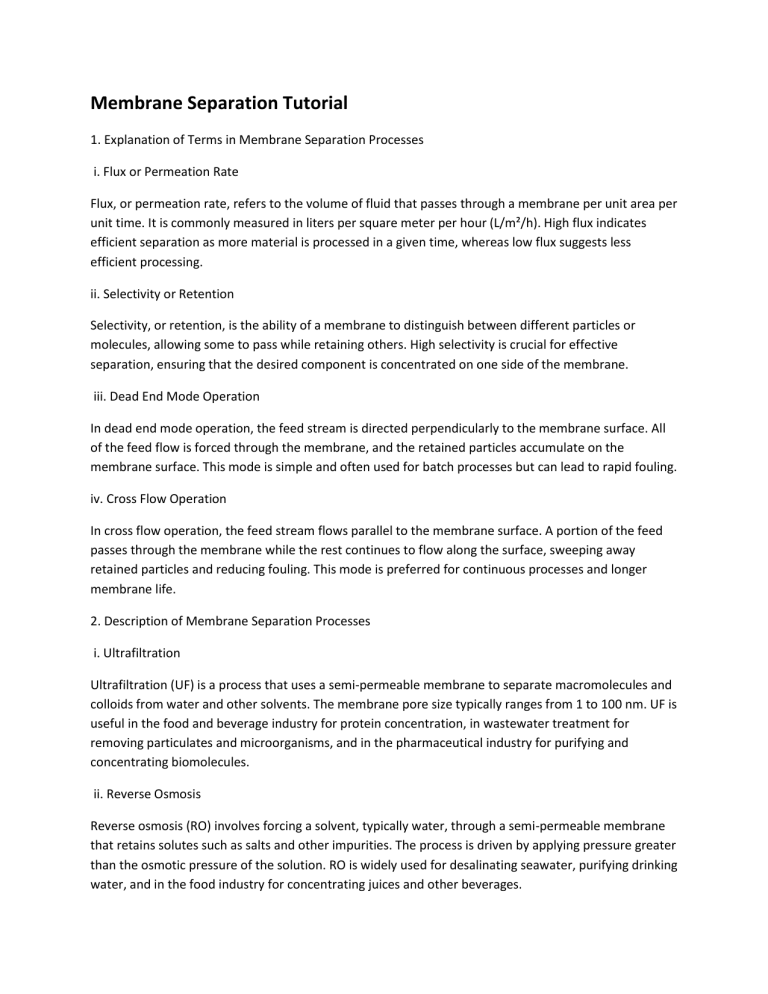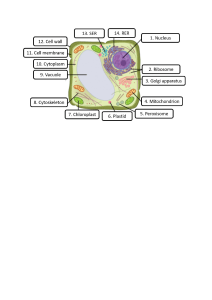
Membrane Separation Tutorial 1. Explanation of Terms in Membrane Separation Processes i. Flux or Permeation Rate Flux, or permeation rate, refers to the volume of fluid that passes through a membrane per unit area per unit time. It is commonly measured in liters per square meter per hour (L/m²/h). High flux indicates efficient separation as more material is processed in a given time, whereas low flux suggests less efficient processing. ii. Selectivity or Retention Selectivity, or retention, is the ability of a membrane to distinguish between different particles or molecules, allowing some to pass while retaining others. High selectivity is crucial for effective separation, ensuring that the desired component is concentrated on one side of the membrane. iii. Dead End Mode Operation In dead end mode operation, the feed stream is directed perpendicularly to the membrane surface. All of the feed flow is forced through the membrane, and the retained particles accumulate on the membrane surface. This mode is simple and often used for batch processes but can lead to rapid fouling. iv. Cross Flow Operation In cross flow operation, the feed stream flows parallel to the membrane surface. A portion of the feed passes through the membrane while the rest continues to flow along the surface, sweeping away retained particles and reducing fouling. This mode is preferred for continuous processes and longer membrane life. 2. Description of Membrane Separation Processes i. Ultrafiltration Ultrafiltration (UF) is a process that uses a semi-permeable membrane to separate macromolecules and colloids from water and other solvents. The membrane pore size typically ranges from 1 to 100 nm. UF is useful in the food and beverage industry for protein concentration, in wastewater treatment for removing particulates and microorganisms, and in the pharmaceutical industry for purifying and concentrating biomolecules. ii. Reverse Osmosis Reverse osmosis (RO) involves forcing a solvent, typically water, through a semi-permeable membrane that retains solutes such as salts and other impurities. The process is driven by applying pressure greater than the osmotic pressure of the solution. RO is widely used for desalinating seawater, purifying drinking water, and in the food industry for concentrating juices and other beverages. 3. Advantages of Membrane Separation Processes Over Traditional Techniques 1. Energy Efficiency: Membrane processes often require less energy compared to thermal separation methods such as distillation. 2. Operational Simplicity: They are generally easier to operate and control, with fewer moving parts. 3. Scalability: Membrane systems can be easily scaled up or down to meet varying production demands. 4. Environmentally Friendly: These processes produce less waste and typically require fewer chemicals. 4. Explanation of Filtration Processes i. Nanofiltration Nanofiltration (NF) employs membranes with pore sizes in the range of 1-10 nanometers. It is designed to remove small organic molecules and certain salts while allowing smaller molecules such as water to pass through. NF is useful in water treatment for removing hardness and organic compounds, in the dairy industry for whey protein concentration, and in pharmaceuticals for purifying products. ii. Pervaporation Pervaporation is a process used to separate mixtures of liquids by partial vaporization through a membrane. The feed liquid contacts one side of the membrane, and the permeate, which is the vapor phase, is collected on the other side, usually under vacuum. This method is particularly effective for separating azeotropic mixtures and removing volatile organic compounds from water. 5. Membrane Module Configurations i. Module Configurations Flat Configurations: 1. Plate and Frame 2. Spiral Wound Tubular Configurations: 1. Tubular Module 2. Capillary/ Hollow Fiber Module ii. Explanation of Modules with Diagrams Plate and Frame Module: A plate and frame module consists of flat sheet membranes and support plates arranged in a stack. The feed solution flows between the plates, and permeate is collected from the sides.  Tubular Module: A tubular module consists of tubular membranes housed within a shell. The feed flows through the tubes, and the permeate passes through the membrane wall into the surrounding shell space. This design is effective for handling high fouling feeds and easy cleaning. These modules are selected based on the nature of the feed solution, the required separation efficiency, and operational considerations.



